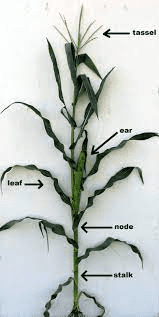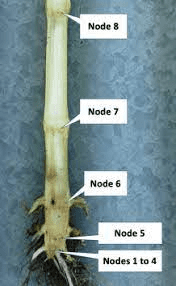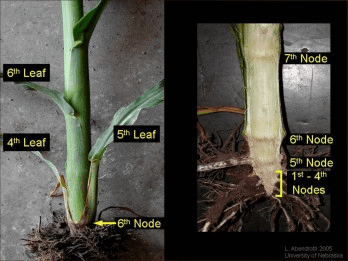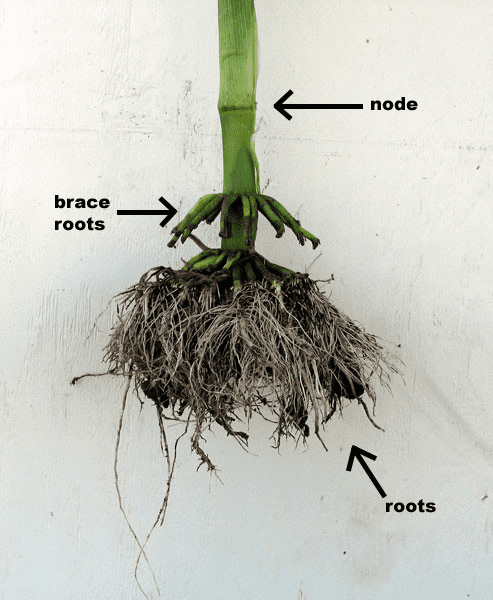Maize/corn nodes are essentially thickened regions along the stalk where the leaves emerge. These nodes are readily identifiable as slight bulges on the otherwise cylindrical stalk. Internally, the nodes boast a complex arrangement of vascular tissues, the plant’s circulatory system. Here, xylem and phloem tissues converge, facilitating the efficient transport of water, nutrients, and photosynthetic products throughout the plant.
The xylem vessels, like tiny pipes, transport water and dissolved minerals upwards from the roots to the leaves. Conversely, phloem transports the sugars produced by photosynthesis in the leaves down to the roots and other growing parts of the plant. This intricate vascular network coordinated at the nodes ensures the vital exchange of resources that fuels the corn’s growth and development.
Beyond facilitating transport, maize nodes also serve as crucial sites of structural support. The nodes are composed of a denser and more rigid form of plant tissue compared to the internodes (the areas between the nodes). This increased density is attributed to the presence of sclerenchyma, a type of supportive tissue rich in tough fibers. Imagine the nodes as reinforced rings along the stalk.
This reinforcement prevents the stalk from buckling or bending under its own weight, especially when laden with heavy cobs. Additionally, adventitious roots, which are secondary roots that emerge from the lower nodes, further enhance the stability of the maize plant by anchoring it more firmly in the soil.
The arrangement of nodes and internodes on the maize stalk is not haphazard. This pattern, known as phyllotaxy, dictates the efficient packing of leaves on the stalk to maximize light capture for photosynthesis. In maize, leaves emerge in an alternate pattern, with each leaf positioned slightly higher and rotated relative to the one below. This strategic positioning ensures minimal shading between leaves, allowing for optimal sunlight absorption throughout the canopy.
The number of nodes on a maize stalk can vary depending on the specific variety and environmental factors. However, there is a general correlation between node number and plant height. Taller corn varieties tend to have more nodes, reflecting the need for additional support structures along the elongated stalk.
Maize nodes are not merely passive structures. They are dynamic regions where the plant regulates growth and development through a complex interplay of hormones. The apical meristem, located at the very tip of the stalk, produces hormones like auxin that influence the formation and development of new nodes and internodes.
Additionally, nodes themselves can produce hormones that regulate tillering, the process by which lateral shoots emerge from the base of the plant. This hormonal interplay ensures the coordinated growth of the maize plant, optimizing its structure for efficient light capture and resource utilization.
Maize nodes are far more than just bumps on the stalk. They are intricate anatomical marvels that orchestrate a multitude of essential functions. From facilitating transport and providing structural support to influencing growth patterns, nodes are the unsung heroes of the corn plant. Understanding their vital role sheds light on the remarkable adaptations that have made maize one of the world’s most productive and versatile agricultural crops.
The Economic Importance and Uses of Maize/Corn Nodes

1. Structural Support: Maize nodes provide structural integrity to the plant, allowing it to support the weight of its leaves and ears. This structural support is crucial for maximizing yield.
2. Nutrient Transport: Nodes are essential for the transport of nutrients and water throughout the plant, ensuring healthy growth and development.
3. Leaf Attachment: Nodes serve as attachment points for leaves, which are critical for photosynthesis and the overall energy production of the plant.
4. Bud Formation: Nodes are the sites where buds form, leading to the development of leaves and branches, contributing to the plant’s vegetative growth.
5. Ears of Corn: The nodes on the main stem and lateral branches are where the ears of corn develop, which are the primary harvestable parts of the plant.
6. Resistance to Lodging: Strong nodes help maize plants resist lodging (falling over), which is vital for maintaining crop quality and yield.
7. Crop Breeding: Understanding the genetic and physiological characteristics of nodes aids in breeding programs aimed at improving maize varieties for better yield and stress resistance.
8. Intercropping Systems: Nodes play a role in intercropping systems where maize is grown with other crops, as they influence plant spacing and growth patterns.
9. Agronomic Practices: Knowledge of node development helps in optimizing agronomic practices such as planting density, fertilization, and irrigation.
10. Pest and Disease Management: Nodes can be points of entry for pests and diseases; understanding their role helps in developing effective management strategies.
11. Silage Production: Nodes contribute to the structural mass of maize plants, which is important in silage production for livestock feed.
12. Biomass Production: Nodes contribute to the overall biomass of maize plants, which can be used for bioenergy production.
13. Genetic Studies: Nodes are important in genetic studies and research on plant development and growth patterns.
14. Stress Adaptation: Nodes help maize plants adapt to environmental stresses such as drought and nutrient deficiencies.
15. Yield Optimization: Effective management of node development is crucial for optimizing yield and quality of maize crops.
16. Crop Rotation: Understanding the growth cycle of nodes assists in planning crop rotations to maintain soil health and productivity.
17. Industrial Uses: Maize plants, including nodes, are used in various industrial applications such as paper and fiber production.
18. Educational Research: Nodes are studied in educational research to understand plant biology and agronomy, contributing to the advancement of agricultural sciences.
Read Also: The Most Lucrative between Production of Fish Fingerlings or Raising them to Table Size
The Products and By-products That Can Be Derived From Maize/Corn Nodes

1. Animal Feed: Maize nodes, along with the rest of the plant, are processed into animal feed, providing essential nutrients for livestock.
2. Silage: Nodes contribute to the bulk of maize silage, which is a key feed source for dairy and beef cattle.
3. Bioenergy: Nodes are part of the biomass used in bioenergy production, such as biofuels and biogas.
4. Compost: Maize nodes can be composted to produce organic fertilizer, enhancing soil fertility.
5. Fiber Production: Nodes, along with other plant parts, can be processed into natural fibers for textiles and other materials.
6. Paper Production: The fibrous nature of maize nodes makes them suitable for paper production.
7. Mulch: Shredded maize nodes can be used as mulch to retain soil moisture and suppress weeds in agricultural fields.
8. Bedding Material: Processed maize nodes are used as bedding material for livestock, providing a comfortable and absorbent substrate.
9. Bioplastics: Nodes are part of the biomass used in the production of biodegradable plastics, reducing reliance on petroleum-based plastics.
10. Industrial Starch: Nodes contribute to the overall starch content of maize plants, which is extracted for various industrial uses.
11. Ethanol Production: Nodes are included in the biomass used for ethanol production, contributing to renewable energy sources.
12. Biogas: Nodes, along with other maize plant parts, are anaerobically digested to produce biogas, a renewable energy source.
13. Soil Amendment: Nodes can be processed into biochar, which is used as a soil amendment to improve soil health.
14. Craft Materials: Dried maize nodes are sometimes used in crafts and decorative items.
15. Research Materials: Nodes are used in scientific research to study plant growth, development, and genetics.
16. Natural Fertilizers: Decomposed maize nodes release nutrients back into the soil, acting as a natural fertilizer.
17. Mushroom Substrate: Maize nodes can be used as a substrate for growing mushrooms, providing a nutrient-rich growing medium.
Read Also: The Best Stage to Start Raising your Catfishes (Fingerlings or Juveniles)
Frequently Asked Questions (FAQ’s) About Maize/Corn Nodes

1. What are maize/corn nodes? Nodes are the points on the maize plant stem where leaves, branches, or buds originate.
2. Why are nodes important for maize plants? Nodes provide structural support, nutrient transport, and attachment points for leaves and ears of corn.
3. How do nodes affect maize yield? Strong, well-developed nodes help support healthy plant growth and ear development, optimizing yield.
4. Can nodes be used in animal feed? Yes, maize nodes are part of the biomass processed into animal feed, providing essential nutrients.
5. What role do nodes play in bioenergy production? Nodes contribute to the biomass used in biofuel and biogas production.
6. Are maize nodes used in composting? Yes, maize nodes can be composted to produce organic fertilizer.
7. How do nodes influence pest and disease management? Nodes can be entry points for pests and diseases, so understanding their role helps in developing management strategies.
8. Can maize nodes be used in industrial applications? Yes, maize nodes are used in the production of fibers, paper, and bioplastics.
9. What is the significance of nodes in crop breeding? Nodes are important in crop breeding programs to develop maize varieties with improved traits.
10. How are nodes involved in silage production? Nodes contribute to the bulk of maize silage, which is a key feed source for livestock.
Read Also: What to Know About Kokedama

